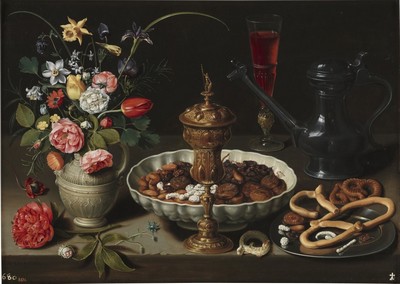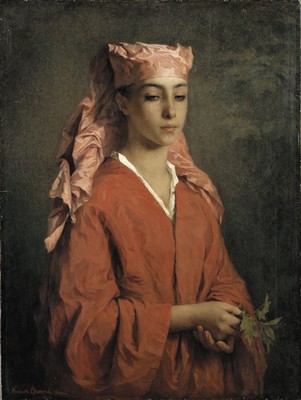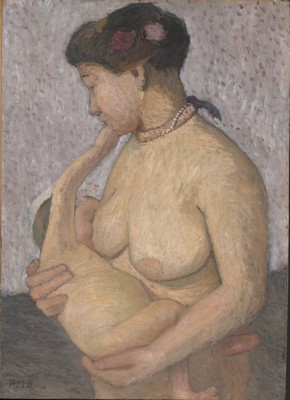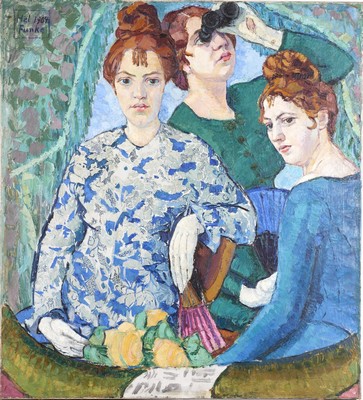WOMEN MASTERS
Museo Nacional Thyssen-Bornemisza, Madrid
31 October 2023 — 4 February 2024
Arp Museum Bahnhof Rolandseck, Remagen
25 February — 16 June 2024
The Sisters, 1869
National Gallery of Art, Washington
Breakfast in bed, 1897
Oil on canvas, 58,4 x 73,7 cm
The Huntington Library, Art Museum,
and Botanical Gardens, San Marino,
donation de la Virginia Steele Scott Foundation
Artemisia Gentileschi, Angelica Kauffmann, Clara Peeters, Rosa Bonheur, Mary Cassatt, Berthe Morisot, María Blanchard, Natalia Goncharova, Sonia Delaunay and Maruja Mallo were celebrated artists in their lifetimes who are now enjoying renewed recognition in response to their erasure from the art-historical account, alongside other lesser-known figures who broke moulds with works of undoubted excellence.
The Museo Nacional Thyssen-Bornemisza is presenting Women Masters, an exhibition curated from a feminist perspective by Rocío de la Villa. It features about 100 works, including paintings, sculptures, works on paper and textiles, which together offer a survey of artistic creations by women from the late 16th century to the early decades of the 20th century, presented in the form of eight sections on contexts of significance for the path towards female emancipation. Starting from the present-day notion of sisterhood, the exhibition focuses on groups of artists, patrons and gallerists characterised by shared values and by favourable socio-cultural and theoretical conditions despite the prevailing patriarchal system. This combination of historical periods, artistic genres and themes constructs the exhibition’s principal axis, allowing it to reveal how these women artists approached important issues of their day, took up positions and contributed new iconographies and alternative gazes. Women Masters is the first major exhibition to reflect the process of feminist rethinking on which the Museo Thyssen has been engaged over the past few years. After its presentation in Madrid, a reduced version of the exhibition can be seen at the Arp Museum Bahnhof Rolandseck in Remagen (Germany).
This is an exhibition on women artists who represent women and their concerns; artists who were in their own day academicians, sought-after by patrons and collectors, participants in associations of women artists, recipients of the highest accolades and the subjects of major exhibitions. In some cases these cultured, intellectually curious, cosmopolitan and committed women also enjoyed the support of their masters, colleagues, husbands, brothers and art dealers.
Exhibited Artists: Anna Ancher —Lola Anglada — Catharina Backer — Alice Bailly — Mary Beale — Cecilia Beaux — María Blanchard — Rosa Bonheur — Marie Bracquemond — Louise Catherine Breslau — Elena Brockmann — Henriette Browne — Catterina Cantoni — Mary Cassatt — Marie Cazin — Camille Claudel — Marie-Anne Collot — Elin Danielson-Gambogi — Sonia Delaunay — Françoise Duparc — Félicie de Fauveau — Lavinia Fontana — Helene Funke — Fede Galizia — Eloísa Garnelo — Giovanna Garzoni — Artemisia Gentileschi — Alejandrina Gessler — Marie-Éléonore Godefroid — Natalia Goncharova — Alice Havers — Johanna Helena Herolt — Frida Kahlo — Angelica Kauffmann — Käthe Kollwitz — Adélaïde Labille-Guiard — Marie Laurencin — Antonia Lavauguyon — Tamara de Lempicka — Judith Leyster — Elena Luksch-Makowsky — Victoria Malinowska — Maruja Mallo — Victoria Martín — Jacqueline Marval — Maria Sibylla Merian — Anna Lea Merritt — Paula Modersohn-Becker — Louise Moillon — Maria Moninckx — Victoria Monkhouse — Berthe Morisot — Mary Moser — Elizabeth Nourse — Clara Peeters — Marie Petiet — María Luisa Puiggener — Emy Roeder — Anna Ruysch — Rachel Ruysch — Ángeles Santos — Helene Schjerfbeck — Anna Maria van Schurman — Zinaïada Serebriakova — Anne Seymour Damer — Elisabetta Sirani — Elizabeth Sparhawk-Jones — Louisa Tenison — Suzanne Valadon — Gertrude Vanderbilt Whitney — Lluïsa Vidal — Louise-Élisabeth Vigée-Le Brun — Marianne Werefkin — Anne Whitney
Porzia wounding her Thigh, 1664
Collezioni d’Arte e di Storia della
Fondazione Cassa di Risparmio, Bolonia
WOMEN MASTERS 1. Sisterhood I. La causa delle donne
The Italian version of the querelle des femmes, the title of the exhibition’s first section refers to the literary and academic debate ongoing in Europe from the late 14th century to the French revolution in defence of women’s intellectual powers and their right to access knowledge and engage in politics in the face of misogyny. In the exhibition this debate is presented through the production of various northern Italian female artists active in the late 16th and throughout the 17th century who worked in the family botteghe and who benefited from a socio-political climate and from theories on art favourable to women in the Papal States. The works presented in this first section are depictions of the lives and deeds of female biblical figures and classical heroines: strong women who triumphed through their virtue and who are symbols of female victory over gender violence and affronts to women in this period. Judith with the Head of Holofernes (1600) by Lavinia Fontana; Judith and her Maidservant (1618-19) and Susannah and the Elders (1623) by Artemisia Gentileschi; and Portia wounding herself in the Thigh (1664) by Elisabetta Sirani are some of the most notable examples.
Still Life with Flowers, a Silver-gilt Goblet, Dried Fruit,
Sweetmeats, Bread sticks, Wine and a Pewter Pitcher, 1611
Museo Nacional del Prado, Madrid
WOMEN MASTERS 2. Botanists, Well-versed in Wonders
The scientific revolution marked the decline of the tradition of botanical, biological and medical knowledge among women, set against the context of the persecution of witches. This section focuses on the role of women artists in the emergence and maximum splendour of the genre of still life, proposing a possible female genealogy with regard to the sub-genre of the still life with insects that derived from an ecological rather than mechanistic vision in the work of artist-scientists such as the German Maria Sibylla Merian. Her work is present in this space alongside that of other 17th-century Italian and Central European women painters such as Fede Galizia, Giovanna Garzoni and Clara Peeters, and French and British ones including Louise Moillon and Mary Beale. The resulting group of works reveals not only the virtuosity achieved by these painters but also their powers of observation and scientific knowledge.
Portrait of a Woman, ca. 1787
Collection du Musée des Beaux-Arts, Quimper
WOMEN MASTERS 3. Enlightened Women and Academy Members
The Enlightenment in France was the period of the salonnières - women who hosted cultural and artistic gatherings, many of whom became serious art patrons and active participants in the cultural debate - and their friendships with intellectuals and artists. In addition, the artistic patronage of Marie Antoinette and the Mesdames was extremely significant for the recognition of the importance of female artistic production, including in the context of the Academy. That production focused on the genre of portraiture, both painted and sculpted, on genre painting and on Neo-classical scenes, depicting a wide range of female roles expressed in a notably theatrical register. Focusing on the period between 1770 and 1850, this section includes relevant works by British, French and Spanish artists active before and after the French Revolution, such as Angelica Kauffmann, Adélaïde Labille-Guiard, Louise-Élisabeth Vigée-Le Brun and Victoria Martin Barhié. Their prominence ended with the expulsion of female academicians following the introduction of the Napoleonic Code of 1804 which deprived women of numerous rights including citizenship following the failed revolution, a model of exclusion that would subsequently be imposed in Spain and the rest of Europe.
A North-African Fellah, 1867
John H. Josephson y Carolina F. Zapf.
WOMEN MASTERS 4. Orientalism/Genre Painting
In the second half of the 19th century at the height of the colonial period Orientalism and the depiction of picturesque scenes from daily life acquired enormous popularity and numerous artists were attracted by both the distant and exotic and the local and rural. This section emphasises the contribution made by women artists to Orientalism and genre painting, revealing how in contrast to the male, patriarchal, even “voyeuristic” colonial viewpoint, they introduced experiences of empathy or affiliation with non-western women, bringing a dignity to the themes and subjects represented. This is evident in the work of French, American and Spanish women artists between the late 18th century and the first decade of the 20th century when the two styles came together. Examples include Rosa Bonheur, with her fascination for the exoticism of Spanish culture, or the renowned Orientalist painter Henriette Browne who produced works in that genre during her travels in Muslim countries. Other protagonists of this trend include Mary Cassatt at the outset of her career in Seville, and Spanish painters such as Alejandrina Gessler de Lacroix, Elena Brockmann de Llanos and María Blanchard.
The Laundresses, 1882
Musée Petiet, Limoux
WOMEN MASTERS 5. Workers, Carers
Excluded from official academies, women from across Europe and America studied in Paris in private, segregated art schools. In the context of growing demands for women’s rights they established the first associations of women artists and the Women’s Pavilion at the World’s Columbian Exhibition in Chicago in 1893. This section presents examples of these artists’ realism and their romantic and political idealism, evident in depictions of female workers engaged both in traditional tasks and in a range of trades and professions, dating from around 1860 to the early decades of the 20th century. In contrast to the figures in depictions by male artists, often shown as isolated and trapped in their work, the female workers portrayed by women are never alone and always interact with each other, emphasising their ties of companionship or solidarity. Washerwomen (1882) by Marie-Louise Petiet, The Cherry Tree (1891) by Berthe Morisot, Housewives (1905) by Lluïsa Vidal, and The Shoe Shop (ca. 1911) by Elizabeth Sparhawk-Jones are some of the outstanding examples in this section.
Mother and Daughter, Half Figure, 1906
Von der Heydt-Museum Wuppertal
WOMEN MASTERS 6. New Types of Motherhood
The subject of motherhood has been one of the most extensively represented in the history of art. It was not, however, until the end of the 19th century that female artists began to depict women’s feelings on this subject, aside from and in opposition to the patriarchal discourse around the “angel of the hearth”. Breakfast in Bed (1897) by Mary Cassatt, Ver Sacrum (Self-portrait with the artist’s son Peter) (1901) by Elena Luksch-Makowsky, Mother and Child, half figure (1906) by Paula Modersohn-Becker, Marie Coca and her Daughter Gilberte (1913) by Suzanne Valadon, and Mother and Child (1932) by Tamara de Lempicka are some of the exceptional works to be seen in this section, which also includes sculptures by Käthe Kollwitz and Emy Roeder.
Twilight Confidences, 1888
Georgia Museum of Art, University of Georgia, Athens
WOMEN MASTERS 7. Sisterhood II. Rapport
In the late 19th and early 20th centuries women artists’ familiarity with the work of the male Impressionists gave rise to depictions of female friends in pairs, threesomes or groups, shown in situations of shared study or leisure time. These are spaces and moments experienced together in which nothing happens, but this is precisely where their interest lies and they offer variations on a new iconography: friendship between women. This section includes examples by European and American women painters dating between 1880 and the 1920s, including Sisters (1869) by Berthe Morisot, Three Women with Parasols (The Three Graces) (ca. 1880) by Marie Bracquemond, Twilight Confidences (1888) by Cecilia Beaux, and The Bouquet (1925) by Lola Anglada.
In the Theatre Box, 1904-1907
Lentos Kunstmuseum Linz. Peter Funke Estate
WOMEN MASTERS 8. Emancipated Women
In the years between 1900 and 1937, when women were achieving the vote in most western countries, the most advanced female artists continued to focus on iconographies that emphasised bonds between women and their distinctive contributions to the new avant-garde languages. Many were active participants in the avant-garde movements, recognised artists who achieved enormous success in life and were examples of strength, commitment, vitality, creativity and independence but who were erased from history and from museums after their deaths or due to historical events such as World War II or the Francoist dictatorship in the case of Spain. Camille Claudel, Jacqueline Marval, Helene Funke, Natalia Goncharova, Frida Kahlo, Ángeles Santos and Maruja Mallo are among the great women artists whose work is exhibited in this final section.
This exhibition was organised by the Thyssen-Bornemisza National Museum in Madrid, in collaboration with the Arp Museum Bahnhof Rolandseck (Germany).
Microsite and Associated Activities
Microsite: Project curated by Semíramis González and Isabel Tejeda which will pursue the arguments presented in the exhibition and offer the viewpoints, accounts and reflections of different contemporary women thinkers and creators.
Film cycle: Women masters’ lives: the legacy and testament of women artists (17th to 20th centuries). 5 November to 10 December 2023. Directed by Ana Quiroga Álvarez.
Lecture series: Spanish Women Masters. Constructing a genealogy of Spanish art. 8 November to 13 December 2023. Directed by Marián López Fdez. Cao.
International symposium: Cultural Interactions. Transmissions and alliances between modern women artists. 18 and 19 January 2024. Directed by Maite Méndez Baiges.
Curator: Rocío de la Villa
Technical curator: Elena Rodríguez, Department of Temporary Exhibitions, Museo Nacional Thyssen-Bornemisza.
Catalogue with texts by Rocío de la Villa, Marta Mantecón, Haizea Barcenilla and Ana Martínez-Collado.
MUSEO NACIONAL THYSSEN-BORNEMISZA
Paseo del Prado, 8. 28014, Madrid










